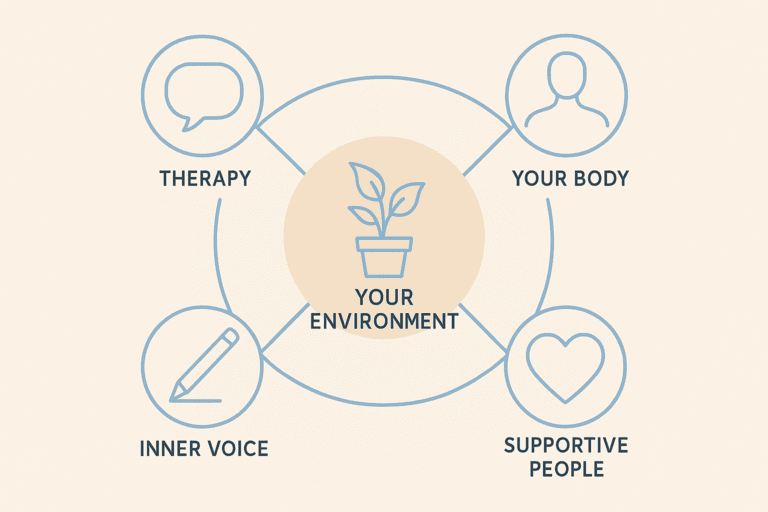5 Places to Turn to for Stress: A Therapist’s Guide to Support That Works

As a therapist, one of the most common concerns I hear from clients is:
“I’m exhausted, anxious, and overwhelmed… but I don’t know where to start.”
Stress has a way of creeping in quietly, then suddenly taking over. It can show up as racing thoughts, a short temper, constant fatigue, or even physical symptoms like headaches, nausea, or tightness in the chest. You may not always recognize it as stress—at first, it just feels like something is off.
Over the years, I’ve supported clients from all walks of life—students, professionals, caregivers, creatives—who are trying to navigate their stress with more clarity and calm. What they all have in common is a desire to feel more in control, more grounded, and more connected to themselves.
If you’re looking for 5 places to turn to for stress, I hope this guide helps you find gentle, practical ways to move forward—even if you’re just beginning.
1. Therapy: A Safe Space to Be Honest and Heard
Naturally, I’ll start here—because I’ve seen firsthand how powerful it can be to talk to someone in a setting that’s confidential, compassionate, and non-judgmental.
In therapy, we don’t just talk about what’s bothering you. We work together to explore the underlying causes, the patterns that keep repeating, and the tools that help you respond instead of react. Whether your stress is tied to work, family, past trauma, or current uncertainty, therapy offers you a place to untangle it all—at your own pace.
For many clients, just having one hour a week that’s entirely focused on their well-being feels like a reset. Therapy is not just one of the 5 places to turn to for stress—for many, it’s the anchor that makes navigating the rest of life possible.
2. Your Body: An Early Warning System
Many of my clients come into sessions feeling confused or overwhelmed—and often, their body is the first place their stress shows up. You might notice:
Tight shoulders or neck
Shallow breathing
Trouble sleeping
Upset stomach
Clenched jaw
When we’re constantly on the go, it’s easy to ignore these signals. But your body isn’t trying to sabotage you—it’s asking you to slow down. One of the things we work on in therapy is how to tune back into the body with compassion.
This might look like:
Taking a five-minute walk during your lunch break
Practicing deep breathing before a meeting
Taking a few minutes to slowly relax each part of your body before bed.
Drinking a glass of water and checking in with yourself
These small moments of awareness can prevent stress from escalating. Reconnecting with your body isn’t indulgent—it’s essential.

3. Your Environment: Spaces That Help You Regulate
Another one of the 5 places to turn to for stress is the space around you. I often ask clients, “Where do you feel most calm?” You don’t need a perfectly designed home to find relief—just a corner or habit that supports your nervous system.
Here are some simple adjustments that can help:
Create a soft-lit nook with a blanket and book
Light a calming candle or use a scent diffuser
Reduce visual clutter (even clearing one surface can feel grounding)
Spend 10 minutes outside in fresh air or near greenery
If you work from home, consider designating a “transition zone”—a space or ritual that helps you mentally shift out of work mode at the end of the day. Your surroundings can either reinforce stress or help release it. Choose intention where you can.
4. Supportive People: Even One Can Make a Difference
When people are stressed, they often feel alone. But even one steady, kind person can offer a sense of safety and grounding. A friend, partner, coworker, mentor—or even a neighbor—can become a vital resource.
Stress can also affect our willingness to reach out. Clients often tell me they don’t want to “burden” others. But sharing doesn’t have to mean dumping everything. Try:
Sending a “thinking of you” message
Going on a short walk together
Sharing something funny or uplifting
Asking to talk, even briefly, without pressure to “fix” anything
Connecting with someone who makes you feel seen—even for a moment—can lower cortisol levels and bring you back into balance. When considering the 5 safe spaces to ease your stress, don’t overlook the power of safe, human connection.

5. Your Inner Voice: Compassion Over Criticism
This one may surprise you. But one of the most underused resources I see in therapy is people’s own inner wisdom. When we’re stressed, our inner voice can turn critical: “You should be able to handle this,” or “You’re falling behind.”
One of my favorite parts of this work is helping clients shift that voice into something softer, more encouraging, and more honest. Journaling, mindfulness, or simply pausing to ask, “What would I say to a friend in this situation?” can change everything.
Try this exercise:
Write down your current worry or stressor. Then write what your most compassionate, wise self would say in response. Over time, this inner dialogue becomes more natural—and so much more helpful.
Final Thoughts
You don’t need a perfect plan or a stress-free life to feel better. You just need a few reliable places to turn when the pressure builds. These 5 places to turn to for stress aren’t magic cures—but they’re real, effective, and within reach.
Therapy, your body, your environment, your connections, and your own voice are tools you carry with you—no matter how busy, uncertain, or messy life gets.
If you’re feeling overwhelmed and don’t know where to begin, you’re not alone. And you don’t have to figure it out alone either.
Let’s talk.
Therapy can help you reconnect with yourself, reduce overwhelm, and create space for clarity and calm. Reach out when you’re ready—I’m here to help.